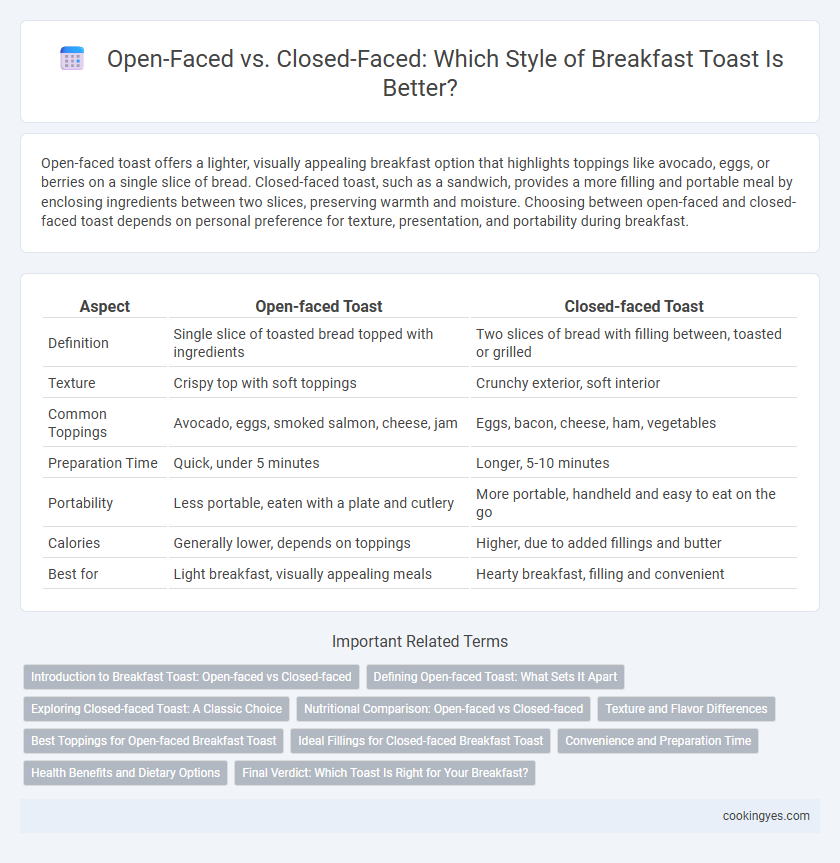Open-faced toast offers a lighter, visually appealing breakfast option that highlights toppings like avocado, eggs, or berries on a single slice of bread. Closed-faced toast, such as a sandwich, provides a more filling and portable meal by enclosing ingredients between two slices, preserving warmth and moisture. Choosing between open-faced and closed-faced toast depends on personal preference for texture, presentation, and portability during breakfast.
Table of Comparison
| Aspect | Open-faced Toast | Closed-faced Toast |
|---|---|---|
| Definition | Single slice of toasted bread topped with ingredients | Two slices of bread with filling between, toasted or grilled |
| Texture | Crispy top with soft toppings | Crunchy exterior, soft interior |
| Common Toppings | Avocado, eggs, smoked salmon, cheese, jam | Eggs, bacon, cheese, ham, vegetables |
| Preparation Time | Quick, under 5 minutes | Longer, 5-10 minutes |
| Portability | Less portable, eaten with a plate and cutlery | More portable, handheld and easy to eat on the go |
| Calories | Generally lower, depends on toppings | Higher, due to added fillings and butter |
| Best for | Light breakfast, visually appealing meals | Hearty breakfast, filling and convenient |
Introduction to Breakfast Toast: Open-faced vs Closed-faced
Open-faced breakfast toast features a single slice of bread topped with ingredients such as avocado, eggs, or smoked salmon, offering a light and customizable meal rich in nutrients like protein and healthy fats. Closed-faced toast consists of two slices of bread with fillings like cheese, ham, or vegetables sandwiched inside, providing a more filling option that combines carbohydrates, fiber, and diverse flavors. Both styles serve as versatile breakfast choices catering to different dietary preferences and energy needs.
Defining Open-faced Toast: What Sets It Apart
Open-faced toast features a single slice of bread topped with various ingredients, allowing the toppings to remain visible and easily customizable. This style emphasizes the texture and flavor of both the bread and the toppings, offering a versatile and visually appealing breakfast option. Unlike closed-faced toast, it skips the sandwich-style layering, providing a lighter and more straightforward eating experience.
Exploring Closed-faced Toast: A Classic Choice
Closed-faced toast, a classic breakfast choice, features toppings sealed between two slices of bread, enhancing flavor integration and providing a hearty, portable meal. This style supports diverse ingredients such as eggs, cheese, meats, and vegetables, offering balanced nutrition and satisfying textures in each bite. Popular examples include sandwiches like grilled cheese or egg salad, which remain staples in many morning routines worldwide.
Nutritional Comparison: Open-faced vs Closed-faced
Open-faced toast typically has fewer calories and less fat since it uses only one slice of bread, reducing carbohydrate and calorie intake compared to closed-faced toast, which sandwiches fillings between two slices. The open-faced option allows for greater portion control and typically contains fewer overall carbohydrates and sodium. Closed-faced toast often provides higher protein and fiber levels when filled with nutrient-dense ingredients but increases total caloric load due to double bread portions.
Texture and Flavor Differences
Open-faced toast offers a crisp, golden exterior that enhances the crunchiness and allows toppings like avocado or smoked salmon to shine with pure, unmasked flavors. Closed-faced breakfast toast sandwiches, by contrast, create a warm, melty interior where ingredients meld together, producing a harmonious blend of tastes and a softer texture. The choice between open and closed-faced toast fundamentally changes the sensory experience, balancing crispness and moisture to suit different flavor preferences.
Best Toppings for Open-faced Breakfast Toast
Open-faced breakfast toast offers a versatile canvas for nutrient-rich toppings like smashed avocado, poached eggs, smoked salmon, and fresh herbs, combining flavor with healthy fats and protein. Incorporating seasonal fruits, ricotta cheese, honey, or nut butters can enhance both taste and texture while providing essential vitamins and antioxidants. Choosing open-faced toast maximizes ingredient visibility and crispness, making each bite flavorful and visually appealing.
Ideal Fillings for Closed-faced Breakfast Toast
Closed-faced breakfast toast pairs perfectly with creamy avocado, smoked salmon, or scrambled eggs, enhancing flavor while maintaining structural integrity. Rich spreads like cream cheese or nut butter complement fresh fruits and nuts to add texture and taste without overpowering the bread. These fillings offer a balanced blend of protein, healthy fats, and natural sweetness ideal for a satisfying morning meal.
Convenience and Preparation Time
Open-faced toast offers quicker preparation since it requires only one piece of bread topped with ingredients, making it ideal for a fast breakfast. Closed-faced toast requires assembling two slices of bread, which usually takes more time but provides a portable, mess-free meal. For convenience and speed, open-faced toast is preferable, while closed-faced toast suits those needing an easy-to-carry option.
Health Benefits and Dietary Options
Open-faced toast offers a lower calorie and carbohydrate option, making it ideal for weight management and heart-healthy diets due to reduced bread consumption. Closed-faced toast, often filled with proteins and vegetables, provides a balanced meal with higher satiety and nutrient density beneficial for muscle repair and sustained energy. Both styles accommodate dietary preferences such as gluten-free or vegan, ensuring versatile breakfast choices that support overall nutrition goals.
Final Verdict: Which Toast Is Right for Your Breakfast?
Open-faced toast offers a lighter, crispier experience perfect for toppings like avocado or eggs, delivering fresh flavors with each bite. Closed-faced toast, with its sandwich-style layering, provides a hearty, portable option packed with protein and vegetables for a more filling meal. Choosing between the two depends on whether you prefer a quick, savory snack or a substantial breakfast that sustains energy through the morning.
Open-faced vs Closed-faced for breakfast toast Infographic

 cookingyes.com
cookingyes.com